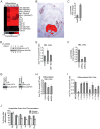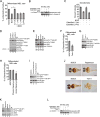The mTORC1/4E-BP pathway coordinates hemoglobin production with L-leucine availability
- PMID: 25872869
- PMCID: PMC4402725
- DOI: 10.1126/scisignal.aaa5903
The mTORC1/4E-BP pathway coordinates hemoglobin production with L-leucine availability
Abstract
In multicellular organisms, the mechanisms by which diverse cell types acquire distinct amino acids and how cellular function adapts to their availability are fundamental questions in biology. We found that increased neutral essential amino acid (NEAA) uptake was a critical component of erythropoiesis. As red blood cells matured, expression of the amino acid transporter gene Lat3 increased, which increased NEAA import. Inadequate NEAA uptake by pharmacologic inhibition or RNAi-mediated knockdown of LAT3 triggered a specific reduction in hemoglobin production in zebrafish embryos and murine erythroid cells through the mTORC1 (mammalian target of rapamycin complex 1)/4E-BP (eukaryotic translation initiation factor 4E-binding protein) pathway. CRISPR-mediated deletion of members of the 4E-BP family in murine erythroid cells rendered them resistant to mTORC1 and LAT3 inhibition and restored hemoglobin production. These results identify a developmental role for LAT3 in red blood cells and demonstrate that mTORC1 serves as a homeostatic sensor that couples hemoglobin production at the translational level to sufficient uptake of NEAAs, particularly L-leucine.
Copyright © 2015, American Association for the Advancement of Science.
Conflict of interest statement
Figures







Comment in
-
Amino acid uptake in erythropoiesis.Sci Signal. 2015 Apr 14;8(372):fs9. doi: 10.1126/scisignal.aab1203. Sci Signal. 2015. PMID: 25872868
References
-
- Bose T, Lee KK, Lu S, Xu B, Harris B, Slaughter B, Unruh J, Garrett A, McDowell W, Box A, Li H, Peak A, Ramachandran S, Seidel C, Gerton JL. Cohesin proteins promote ribosomal RNA production and protein translation in yeast and human cells. PLoS Genet. 2012;8:e1002749. doi: 10.1371/journal.pgen.1002749. - DOI - PMC - PubMed
Publication types
MeSH terms
Substances
Grants and funding
LinkOut - more resources
Full Text Sources
Other Literature Sources
Molecular Biology Databases
Research Materials

